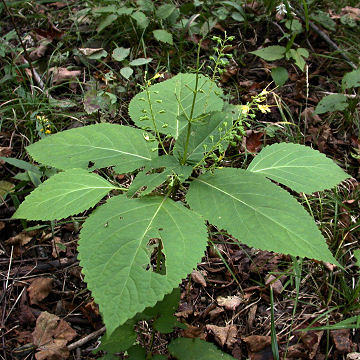

Collinsonia canadensis - (image 1 of 4)
Taxonomy
Family: Lamiaceae
Habitat
Rich woods.
Associates
Distribution
Quebec west to MI and southern WI, south to FL and AR. Very rare in the Chicago region.
Morphology
Upright herbaceous perennial to 1.2 m from a thick, woody rhizome. Leaves in several pairs, serrate, opposite, ovate, acuminate, glabrous; lower leaves larger and petiolate; upper leaves smaller and often sessile. Inflorescence a terminal panicle; flowers yellow; stamens 2.
Notes
Flowers July to September
Wetland indicator: Facultative
The flowers and leaves of this plant have a lemony scent. I have attempted to research the etymology of the name "horse-balm" but have found nothing conclusive as accounts vary considerably. It may mean that horses liked to eat the plant, it was good for curing saddle rash, or it might just mean that the plant is ragged in appearance. The original meaning might have been lost a long time ago.
References
Gleason, Henry A. and A. Cronquist. 1991. Manual of Vascular Plants of
Northeastern United States and Adjacent Canada. Second Ed.
The New York Botanical Garden. Bronx, NY
Swink, F. and G. Wilhelm. 1994. Plants of the Chicago Region.
Indiana Academy of Science. The Morton Arboretum. Lisle, Illinois.
USDA, NRCS. 2002. The PLANTS Database, Version 3.5 (http://plants.usda.gov).
National Plant Data Center, Baton Rouge, LA 70874-4490 USA.
|
Michael Hough © 2004 |